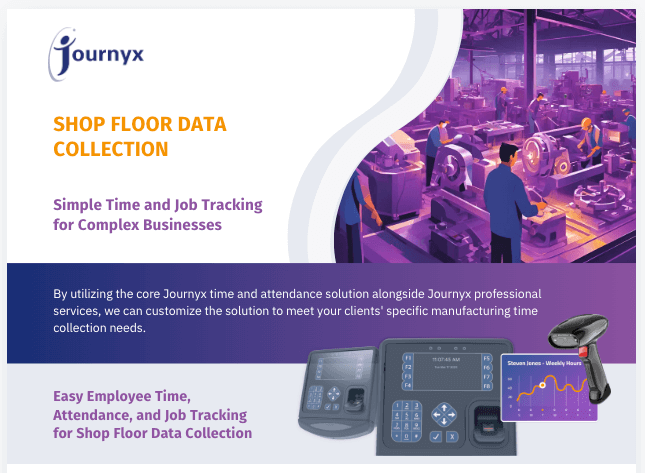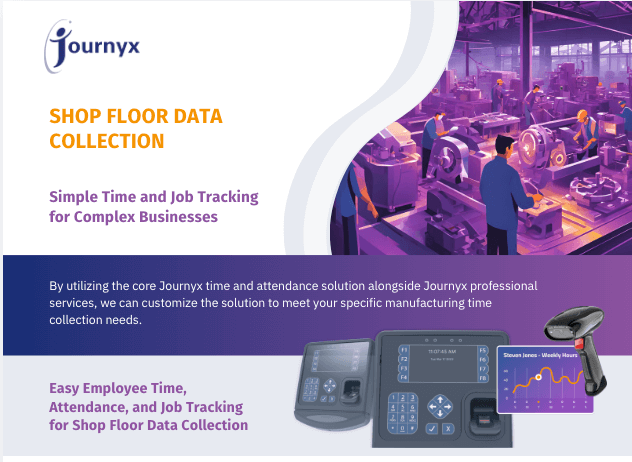How to Properly Budget for a New Time & Attendance System
Developing a Budget for a New Time and Attendance System
Planning and budgeting for implementing a new time and attendance system can seem like a huge burden. And keeping your time and attendance system within budget can be difficult.
Equipped with the right information, however, implementing a new, more efficient system can be easily managed by your team with confidence.
This article will help you identify important purchase considerations, best practices, and ways to save money when budgeting for a new time and attendance system.
Essential Time & Attendance System Budgeting Considerations
Scope of the System
When considering time and attendance systems, the scope can refer to the number of employees who will use the system, the number of locations, mobile support, and so forth.
First, figure out how many employees you’d like to track in the system. Most time and attendance providers charge by the number of employees in the system, so ask what discounts you might receive based on user volume (i.e. your staff headcount). Most providers offer discounts for enrolling more employees. You will then be able to decide if you should keep all employees in the system, or limit the system to non-exempt employees only, for instance.
Employees who are minors (under the age of 18) must also be taken into consideration because their labor is regulated differently. Being fully compliant with labor laws is vital in eliminating legal risk. Using an automated time and attendance system enables the use of automatic scheduling, which can prevent minor employees from working past their legal limits.
Similarly, ensuring compliance with union employees and the specific terms of their labor can be assisted and automated by your time and attendance system if it can handle custom rules tracking.
Most time and attendance systems, however, are not robust enough to manage rules for employees who are minors or union employees effectively. If you employ minors or union members, make sure your time and attendance software accommodates the management of these employees, like Journyx time clock software does.
Time Clock Hardware
Intuitively, you probably already have a good idea of what kind of hardware you want. Based on internal buddy punching problems, you would know if a badge or RFID system will suffice or if you’ll require a biometric system that verifies employees’ identities.
Your time clock options will span from very basic punch clocks to advanced biometric systems that support contactless clocking, job or task tracking, and shop floor automation. It goes without saying that you will need to budget more for each feature you want to include.
Time and attendance hardware you may need to consider purchasing includes:
- Time Clocks (Standard, Proximity, or Biometric)
- Handheld Devices
- Company Cell Phones (for Mobile Workforce)
- Access Control Systems
- Barcode Scanners
Many vendors offer rental programs for hardware. Others will sell employee time clocks and other hardware directly, reducing long-term costs. A best practice when reviewing hardware is to ask how you will be charged for hardware because it may inflate the total cost of ownership to rent a time clock indefinitely.
Of course, for budgeting purposes, you’ll need to estimate costs and multiply by the quantity you’ll need.
Most commodities like cell phones and barcode scanners can be found on any business-oriented eCommerce site. However, time clocks, handheld mobile devices, access control systems, and other hardware can be hard to find on eCommerce or shopping comparison sites because many devices feature options that significantly impact their pricing. You’ll need to ask vendors for quotes on these items based on your specific configuration. Biometric functionality, internet connectivity, and advanced functions might all influence the price of a new piece of hardware.
If you’re buying more than a few units of any given hardware, be sure to ask about quantity discounts. For time clocks, many vendors offer price breaks on bulk orders, which can bring the unit cost down.
Time clocks vary in price depending on the model of time clock you are purchasing, the number of employees to be managed, and the desired features. More advanced biometric time clock systems go at a premium, so plan accordingly. It’s advisable to get a price estimate from a vendor that has a variety of options tailored to your business needs.
Managing Multiple Locations & Mobile Employees
Next, you need to know how many time clocks you will need for your employees. Most companies affix time clocks at every (primary) entrance to their workplace. This provides fast and convenient punching for all employees.
It’s often best to use a practical approach when considering the number and location of time clocks you’ll need. If you have 100 employees who all clock in at 8:00 AM sharp, then it might be problematic to only have one piece of hardware for clocking in and out. Employees who arrive on time would have to wait in line to punch in. For large facilities, having multiple time clocks installed on site by each entrance is a highly recommended best practice.
Another important consideration regarding locations is whether the system needs to manage more than one time zone. If your company has locations across the US or across the globe, you need to ensure the vendors on your short list support multiple time zones, budgeting accordingly if the vendor charges a premium for this feature.
Before implementing a new time and attendance system, ask yourself the question: “Do I need to track mobile, remote, and off-site employees in the same system along with all other employees?” If so, you will have to ensure the time clock vendors on your short-list support this function.
Cost considerations for mobile workforce time and attendance tracking may include fees for additional modules, mobile app access, and geofencing, depending on the vendor’s implementation model.
Advanced Time & Attendance Functionality
Next, you will need to decide if your system requires other advanced functionality within the time and attendance system itself.
Most vendors offer a basic system with the option to upgrade to fit specific needs. If you are only looking for basic time and attendance functionality, there may be numerous vendors that suit your needs. Your selection and budgeting process will likely rely on finding the most competitive pricing for the software and/or hardware that best meets your needs, but it’s advisable to go with a provider that can scale up as your business needs grow.
If you would like your system to perform additional tasks such as advanced payment capability, benefit accruals, cost forecasting, or resource management, these features may require more sophisticated, and more expensive software.
Depending on the vendor, time & attendance system enhancement modules might include:
- Support for larger company sizes
- Support for more administrators or supervisors to use the system
- Benefit accruals
- Advanced payment capability
- Overtime tracking
- Shift differentials
- Pay classes
- Task and labor tracking
- Cost of labor forecasting
- Skills and certifications
- Points and demerits
- Automated alerts
- Time-off management
- Employee communication
- Email templates
- Self-service employee portals
- Mobile support
When selecting software vendors, you should start with some background research. Review their websites, and make sure they offer the functionality you are looking for. Contact the vendors who you feel could best suit your needs and identify those that charge a premium for each individual feature.
If the quotes you receive are far more than you expected and are prepared to budget for, you should reconsider certain features to better fit your budget. Remember, the more functionality you require, the larger the budget for your system. Know what features are necessary for your desired functionality, and which you can omit to fit the budget. Some providers may even be able to support advanced features after implementation, allowing your business to scale up features and services over time.
Delivery Model: Licensed or Cloud Time & Attendance
Two options are available when choosing how you will access your software: the traditional licensed software model, and the web-based cloud model (sometimes called software as a service or SaaS).
Licensed software delivery means that you would pay the software vendor for a license to run their software on your own servers. With this option, you sometimes have more control over how the software functions, but this also comes with the responsibility of operating and maintaining the servers it runs on. In addition, version control and software updates become your responsibility too. This means that keeping up to date with the newest features released for your software might cost more as features and add-on modules are released. You will also need to take extra steps to defend your system, as security updates for licensed software may not be provided even as software vulnerabilities are found.
Licensed systems may also take longer to implement because they require dedicated IT staff and hardware to be set up for your business and may cost more overall because of the increased expenses of licensing, server maintenance, and staffing. Between the initial costs of implementing such a system and the ongoing costs paying for features and keeping the system functional and up-to-date, licensed implementations can easily go over-budget.
Cloud software delivery involves signing up for a service through a software provider. Cloud providers will charge a recurring fee in exchange for access to a widely available system that is much easier to implement. In the cloud delivery model, the software vendor manages and maintains the servers their software runs on, allowing users to access that software through the cloud. Product updates, security patches, and incremental upgrades are performed by the vendor in the background, so you’re always on the most up-to-date versions available.
Sometimes cloud systems are easier to obtain management approval for, as the costs are incurred on a predictable basis. Some service providers offer price discounts when contracting for long-term service, which may lower the monthly or yearly cost of accessing their software.
For many businesses, cloud delivery is the most viable option because it allows them to avoid the overhead costs of hiring additional technical staff, owning and operating servers, and licensing software that may exceed their available budget.
Business System Integration
Another line item to consider in your budget is integration between business systems. This goes beyond a simple file export to your payroll system; true system integration will automatically synchronize communications between your time and attendance system, payroll system, HR management system, ERP system, databases, and other manufacturing and business systems.
Many time and attendance vendors simply do not provide true system interoperability; they just export a file for payroll. Before creating your vendor short-list, find out which vendors offer true integration services for their time and attendance solution with your current business systems. Interoperability not only saves you time but reduces the margin for error as well due to the elimination of manual intervention.
Regarding hardware, some vendors may be able to integrate new systems with legacy hardware. This will allow you to keep any existing time clocks you may have instead of purchasing completely new hardware. Keeping your existing hardware can reduce your budget significantly when planning a new time and attendance system. Experienced vendors will be able to replace old time clocks individually instead of swapping-out entire fleets.
One of the most important budgeting considerations should be the cost of implementation and system configuration to meet your specific business requirements. Without expert implementation, the best hardware and software money can buy might be practically useless. Trying to save time and money by rushing implementation is a dangerous and costly option.
Without assistance from an experienced vendor, your implementation may result in undue headaches, project timeline extensions, incorrect compensation or accruals, or even payroll failure because the system was not setup properly.
To get an idea of what a full-service professional implementation looks like, and the dangers of a careless implementation, read about why you should never cut corners on system implementation.
Expert Support
When considering your budget, high quality support should also be a priority. A qualified expert support program insures your investment. Many vendors charge a premium for emergency service calls—sometimes up to several hundred dollars an hour—so the cost of a high-coverage support package can potentially pay for itself after just one incident.
While cloud time tracking system providers will maintain their servers and software, sometimes additional support is needed to quickly address any issues a user might encounter. Support packages for cloud software may vary, but often ensure faster response times and the highest quality of service.
Contact us to learn more about Journyx’s premier time and attendance offerings, or let us know if we can help you with your budgeting and vendor selection process for your new and improved time and attendance system. We’re happy to work with you to determine the best options for your business.
Let’s Get Started. Book a Demo Today.
Journyx helps you track time for projects, payroll, and more. Learn how Journyx can help you use time to your advantage in your business.



